New England Clam Chowder
One of the first American recipies that describes well the immigrant soul of the place
Almost a year ago, on February 2023, I stepped foot on Boston for the first time. It was a short visit. My husband and I were trying to decide which city (in the US) made more sense for us to move to. The options we were thinking of were somewhere in the Bay Area, probably San Francisco, or Boston.
The latter was the last stop before going back to Budapest, and it won us over, maybe out of contrast with San Francisco or perhaps for its own merits. It was February but it was not as cold as I had imagined, and it was tidy, the sun was shining and you could feel the history of the place.
We didn’t do many of the touristy stuff as we were there to have a feel of the city and to envision how our daily life would be. Still, we found ourselves stopping at Ye Olde Union Oyster House for a pint of beer and a comforting bowl of hot clam chowder coming back from a walk around the Long Wharf.
It was the first time I tried a chowder, any kind. To me, it was a strange concept, I’m not going to lie. In Catalonia, we don’t usually mix seafood with cream or milk. That is reserved for desserts with the only exception of bunyols de bacallà (cod fritters) and croquetes de marisc (seafood croquettes). Never before I had had a white and lumpy soup before me. Specially one that tasted so good.
What is the New England Clam Chowder
New England clam chowder is defined as "a thick chowder made from clams, potatoes, onions, sometimes salt pork, and milk or cream." For those of you who have never encountered the term before or who haven’t guessed by now, a chowder is “a soup or a stew of seafood”. There are different varieties in the country (we’ll talk about it later), but the New England one is considered the most classical. As historian Christopher G. Bates states “few foodstuffs are more closely associated with a particular place than clam chowder is with New England”.
There are many different recipes nowadays, however. When I asked Justice, the waiter that served us last time we visited the Union Oyster House, he said they only add cream, no flour as thickening agent and they opt for salt pork rather than bacon. I have done my research and it seems to be the most simple and traditional way. This is how I’ve also made it at home.
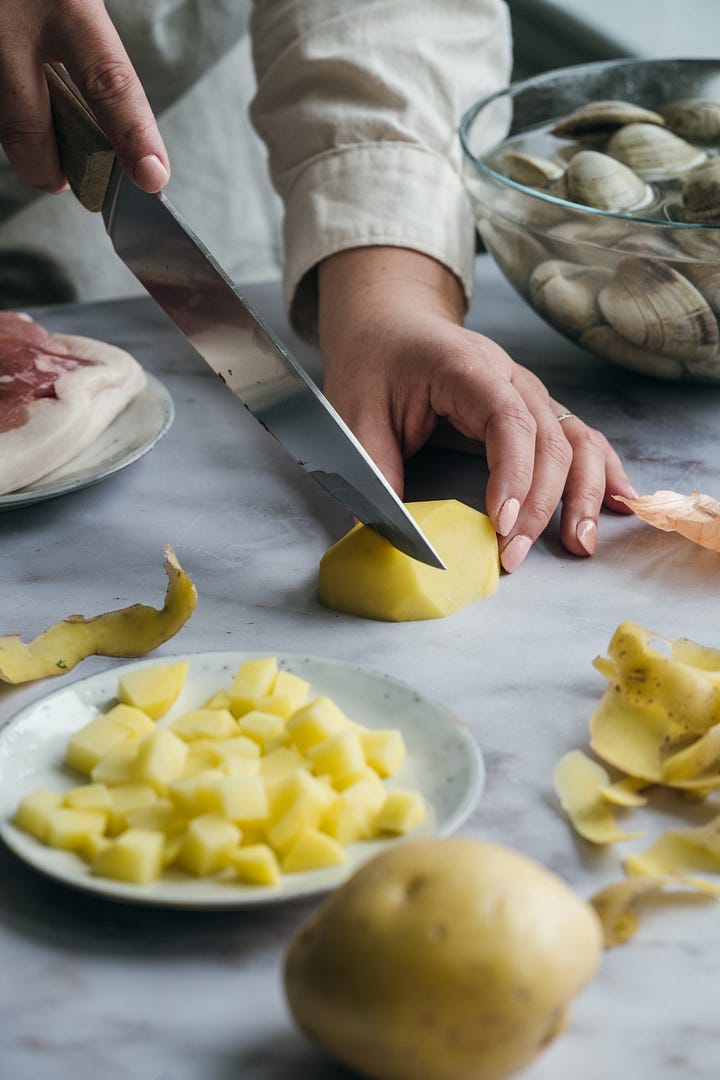
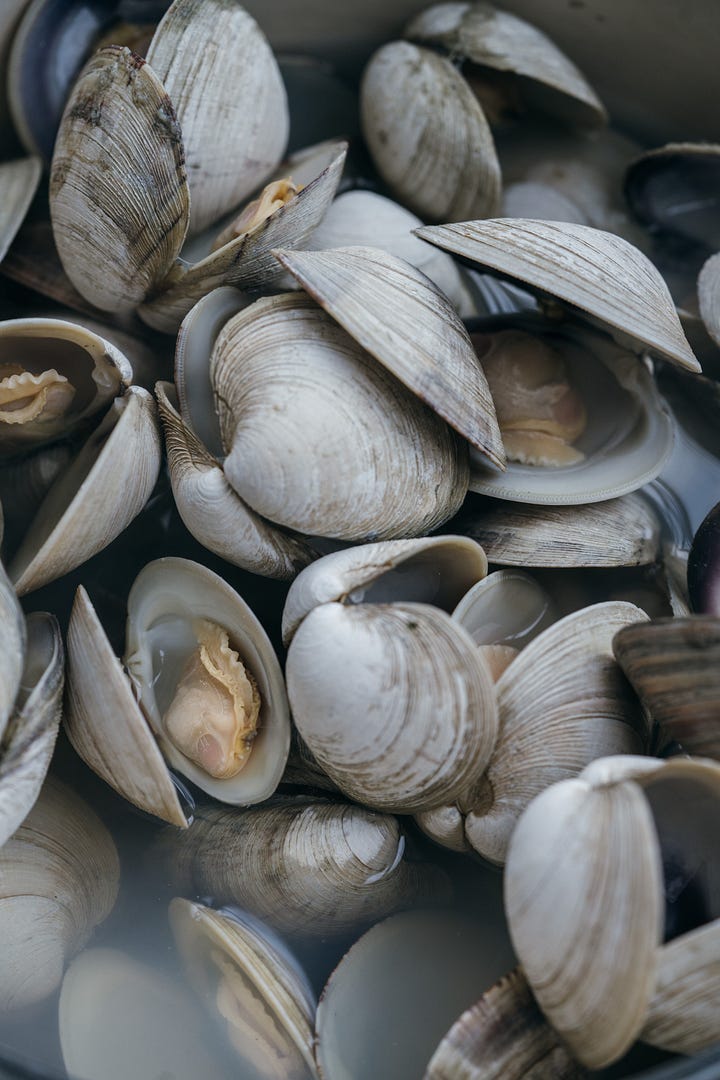
First you steam the clams (littleneck in my case) after cleaning their shells. When they are all open, you discard the shells, chop the clam meat and and put it aside. The broth has to be properly strained (I used a cheesecloth) to remove all impurities from the shells. That broth is golden, so don’t you dare discard it!
You can use the same pot (cleaned up a bit) to fry the salt pork. I don’t think it’s necessary because the pork is very fatty already, but all the recipes I found ask for some butter, so that’s how I did it as well. When the pork is cooked, you should take it out. The pot will be full of liquid fat, so you can then cook your minced onions, until they are soft.
After that you’ll add the diced potatoes and then the clam broth, just enough to cover the potatoes (or more if you prefer a more liquid soup). This will simmer for 10-15 minutes, until the potatoes are tender. Then you can add the chopped clams, the salt pork and the cream and let it simmer again before taking it out from the heat source. To serve, you can add fresh ground pepper and oyster crackers.
Many recipes I have seen, add flour to make a kind of roux that would thicken the soup. Others call for bacon instead of salt pork. Bacon gives it a deeper flavour as the pork is not only cured but also smoked. It is also easier to find than salt pork. Other recipes experiment with flavours, and what The New York Times calls “The Best Clam Chowder Recipe” has white wine, bay leaf, thyme and parsley in it and substitutes the onion for leek. Very continental.
Still, as The Minimalist (Mark Bittman) says, the best clam chowder is the one made with the proper clams. Skip the canned clams if you have the option and go to your preferred fishmonger for 2 or 3 pounds of littleneck clams, cherrystones or whatever variety you have close by. You’ll feel the sea in your mouth.
When was it invented
It is difficult to pinpoint exactly when clam chowder became a thing in the colonies, but we know that on September the 23th, 1751 the Boston Evening Post published the following recipe, the first one ever published of the dish:
First lay some Onions to keep the Pork from burning, Because in Chouder there can be no turning; Then lay some Pork in Slices very thin, Thus you in Chouder always must begin. Next lay some Fish cut crossways very nice Then season well with Pepper, Salt, and Spice; Parsley, Sweet-Marjoram, Savory and Thyme; Then Biscuit next which must be soak’d some Time. Thus your Foundation laid, you will be able To raise a Chouder, high as Tower of Babel; For by repeating o’re the Same again, You may make Chouder for a thousand Men. Last Bottle of Claret, with Water eno’ to smother ‘em, You’ll have a Mess which some call Omnium gather ‘em.
According to Savoring Gotham: A Food Lovers Companion to New York City, it was the French, Nova Scotian or British fishermen the ones that introduced chowders into New England, and they were popular dishes already by 1730. In the early decades of the 19th century the dish also appeared in different cookbooks and by 1836 it was being served in Boston at Ye Olde Union Oyster House (the oldest continuously operating restaurant in the country). Perhaps even a similar recipe to the one I tasted.

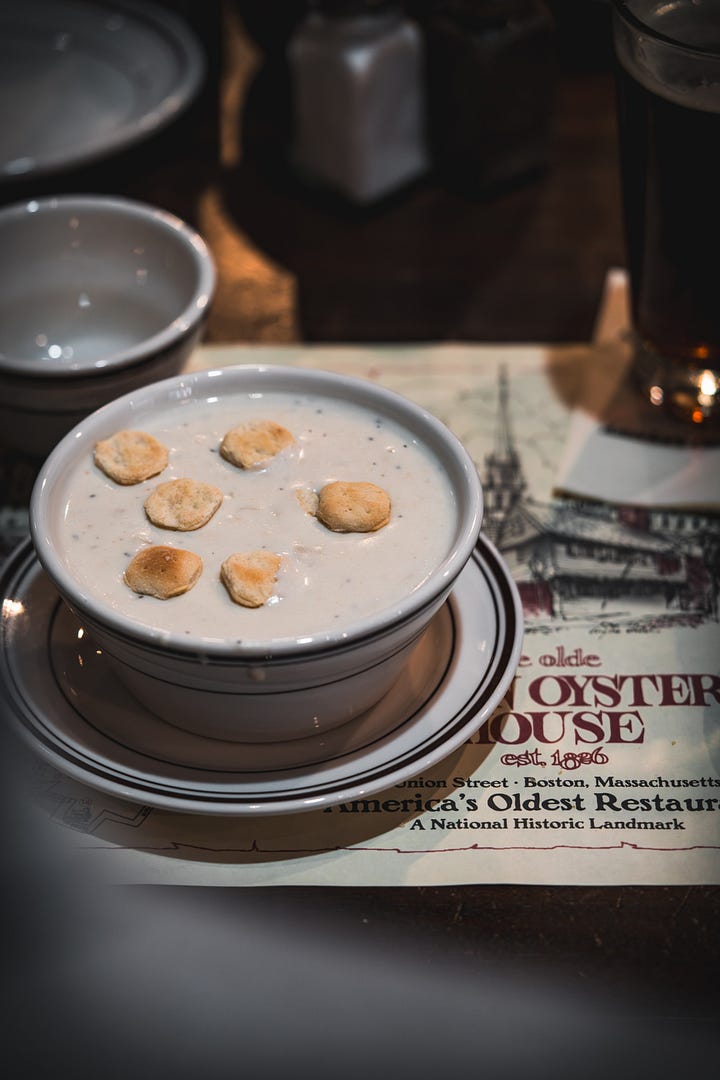
History is really fascinating because it seems that the indigenous tribes of New England were already making a similar concoction hundreds of years ago. Tribes like the Mohegan's, Pequot, Narragansett, Mi'kmaq, and Wampanoag would make a seafood stew with corn, beans, oysters, mussels and quahogs (a giant, hard-shelled clam that can be found in New England’s coastline). It is known that clams and mollusks were a staple in their diet and their shells were even used as currency when the English started their settlements (processed as beautiful Wampum beads).
Around the early 18th century, the europeans that arrived to New England would enjoy a comparable stew to the one that was well known locally. As fishermen and sailors, they would add whatever they caught that day with broth into a cauldron, or chaudière, world that is believed gave the name to the modern version of the soup.
Actually, clams only slowly made a preferred appearance in the chowder. In the first half of the 19th century, both fish chowder and clam chowder existed simultaneously, as we can read in the following passage found in Moby-Dick (Herman Melville, 1851).
“However, a warm savory steam from the kitchen served to belie the apparently cheerless prospect before us. But when that smoking chowder came in, the mystery was delightfully explained. Oh, sweet friends! hearken to me. It was made of small juicy clams, scarcely bigger than hazel nuts, mixed with pounded ship biscuit, and salted pork cut up into little flakes; the whole enriched with butter, and plentifully seasoned with pepper and salt,” declaims Ishmael. The cod chowder, which he tries next, is just as good, but possesses “a different flavor.”
Milk was added later to finish up what is today known to be the “traditional New England clam chowder”. Historian Robert S. Cox explains in his book A History of Chowder: Four Centuries of a New England Meal (The History Press, 2011) “It was made at sea by men for an all-male audience. They would render salt pork, add a layer of fish, a layer of onions and a layer of crackers and pour water over the whole thing. There were no potatoes, no cream.”
Cox adds that between 1800-1840 women started making the dish at home, refining it with herbs such as tarragon and adding milk “probably because of an increase in dairy herds”. Chowder evolved with the industrialisation of New England and it was the perfect meal after a hard day’s at work. The milk provided extra nutrients and a soothing texture while clams, abundant and cheap, where the preferred source of protein.
Different chowders and their ingredients
As we have seen, clam chowder originated in the cauldrons of the ships’ galleys in front of the New England coast. Probably inspired both from the soups that Native Americans prepared at the time and the soups that the first settlers used to make back home in France or England. It’s one of America’s first recipes and it speaks of the history of the country.
If we consider its ingredients: there’s a mix of locally found flavours (clams), imported ingredients (pork, milk cows, onions, wheat for the biscuits and black pepper) and ingredients that are local to the continent but had to travel to Europe and back (potatoes).
The United States is a land of immigrants and their ingredients and dishes show that. Cattle arrived to the continent with the second trip Columbus took on 1494 and by 1512 stock-raising was a fixed industry in the West Indies. After the Plymouth Colony was stablished on 1620, the English settlers imported milk cows and pigs from the Spanish colonies into Massachusetts. The potato, an ingredient native to South America, only arrived to the Northern part of the continent on 1719. It was grown near Boston by Scotch-Irish immigrants, for whose the tubercle was 100% European.
Wheat also arrived to the continent with the Spanish colonisers but it seems that it was the English who introduced it centuries later to New England. The first recipes of clam chowder call for biscuits to thicken the soup. Nowadays it’s more common to garnish it with oyster crackers. Oyster crackers are crackers, indeed, but they have no oyster. They are just bread biscuits that may have been added to oyster soup (therefore the name) and were given shape and fame by Westminster Bakers. This popular New England company started baking their hexagonal crackers on 1828 in Westminster, Massachusetts and many New Englanders now believe a bowl of clam chowder is incomplete without them.
Clam chowder has traveled all around the United States and it has been incorporated in different gastronomic traditions. In Florida, they have something called the Minorcan clam chowder, made with tomato broth and Spanish datil pepper. It seems that these peppers were brought to St. Augustine, Florida by indentured workers from Menorca (Spain) in the late 18th century. I’ll tell you now, I’ve never in my life seen such peppers in Spain. But perhaps my ancestors had a more adventurous taste for spicy food!
In San Francisco they serve a similar version to the New England one but you’ll find the soup inside a sourdough bread bowl. They also have their own versions in New Jersey, Delaware, Seattle and even in Cabo (Mexico). However, it’s around the states of the East Coast where things get messy. And some even call it “the clam chowder wars”.
In Rhode Island they like it clear. Just broth, no cream. Perhaps more authentic to the original before milk was added. But the most competing version to the New England one, and the version that started the wars, is the Manhattan clam chowder. As the well known rivalry between the Boston Red Sox and the New York Yankees, the competition between chowders is real. It all began after the cookbook Soup and Sauces (1934) featured a recipe of a tomato based chowder.
This recipe substituted tomatoes for milk and added other vegetables like carrots, celery, onion, and garlic. While it had its supporters, it also brewed a lot of hate. Famed cook James Beard that was a New Yorker since he was 24 years old wrote about it in his book American Cookery (1972): “That rather horrendous soup called Manhattan clam chowder,” […] “resembles a vegetable soup that accidentally had some clams dumped into it.” It seems he was not convinced.
Some got even angrier. In 1939 a Maine legislator introduced a bill outlawing the use of tomatoes in chowder. And the Massachusetts writer Eleanor Early called the tomato based version a “terrible pink mixture” […] “is only a vegetable soup and not to be confused with New England Clam Chowder, nor spoken of in the same breath. Tomatoes and clams," she wrote, "have no more affinity than ice cream and horseradish.”
It’s very interesting she noted that when the most famous French soup (country where perhaps the chowder even comes from) is the bouillabaisse, a seafood soup that undoubtedly has clams and tomato in it. It is true that milk is also mixed with seafood in France, but I would say it’s no so obvious. Perhaps in a béchamel (which is the case of my croquetes de marisc), or in the seafood version to the veal milk soup blanquette.
Ingredient wise, tomatoes are more American than cow milk is. American as in American continent. But history likes its twists and turns and tomatoes, that were grown in Mexico for centuries before the Europeans even set foot there, only arrived to the East Coast with the English settlers. By the early 19th century tomatoes were present in many towns in the United States, but most people didn’t eat them, they were thought to be poisonous. Indeed, until 1820 they were no recipes of tomato-based dishes. It all started to change when Dr. John Cook Bennett claimed tomatoes were a healthy food source that could be used to treat ailments such as diarrhoea and started prescribing “tomato-pills”.
Let’s leave on a positive note and remember the praising words Joseph C. Lincoln (1870-1944), author of 47 books and plays about Cape Cod wrote about New England clam chowder:
A New England clam chowder, made as it should be, is a dish to preach about, to chant praises and sing hymns and burn incense before. To fight for. The Battle of Bunker Hill was fought for–or on–clam chowder; part of it at least, I am sure it was. It is as American as the Stars and Stripes, as patriotic as the national Anthem. It is ‘Yankee Doodle in a kettle.’
A very American dish indeed and the first of this series about New England identitary dishes.


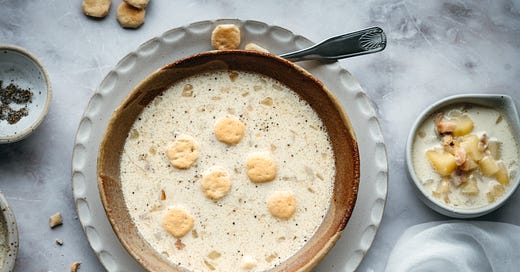




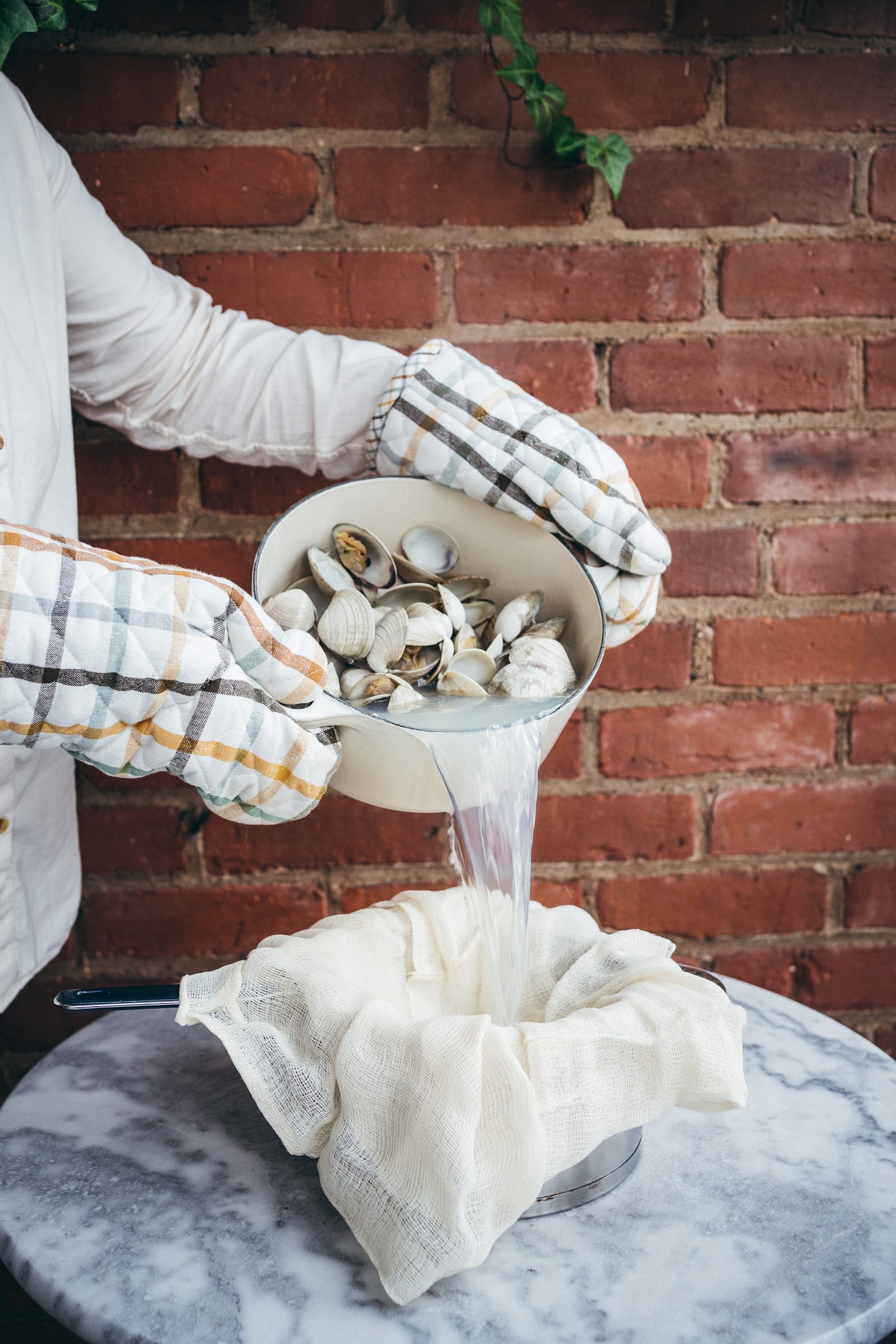

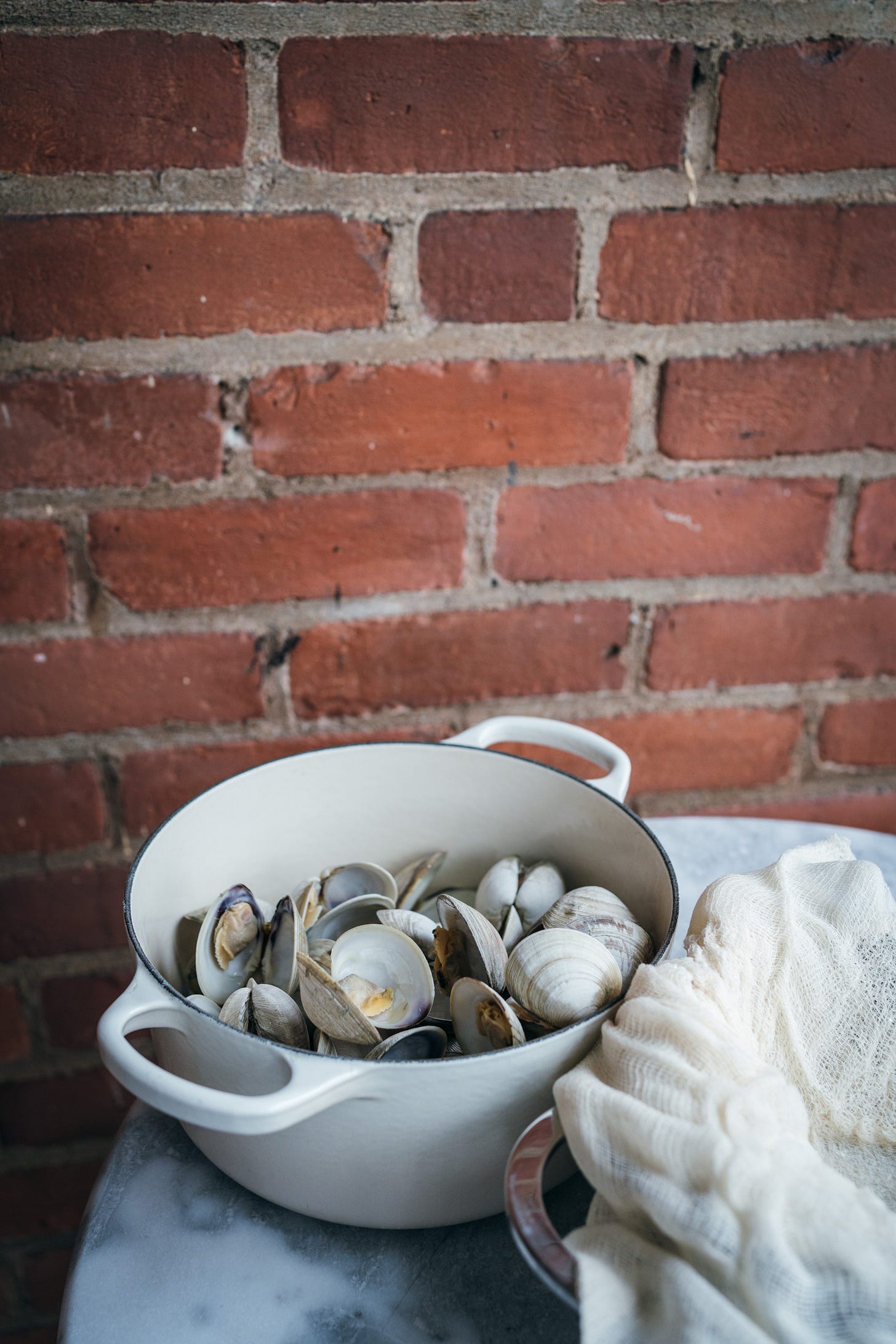

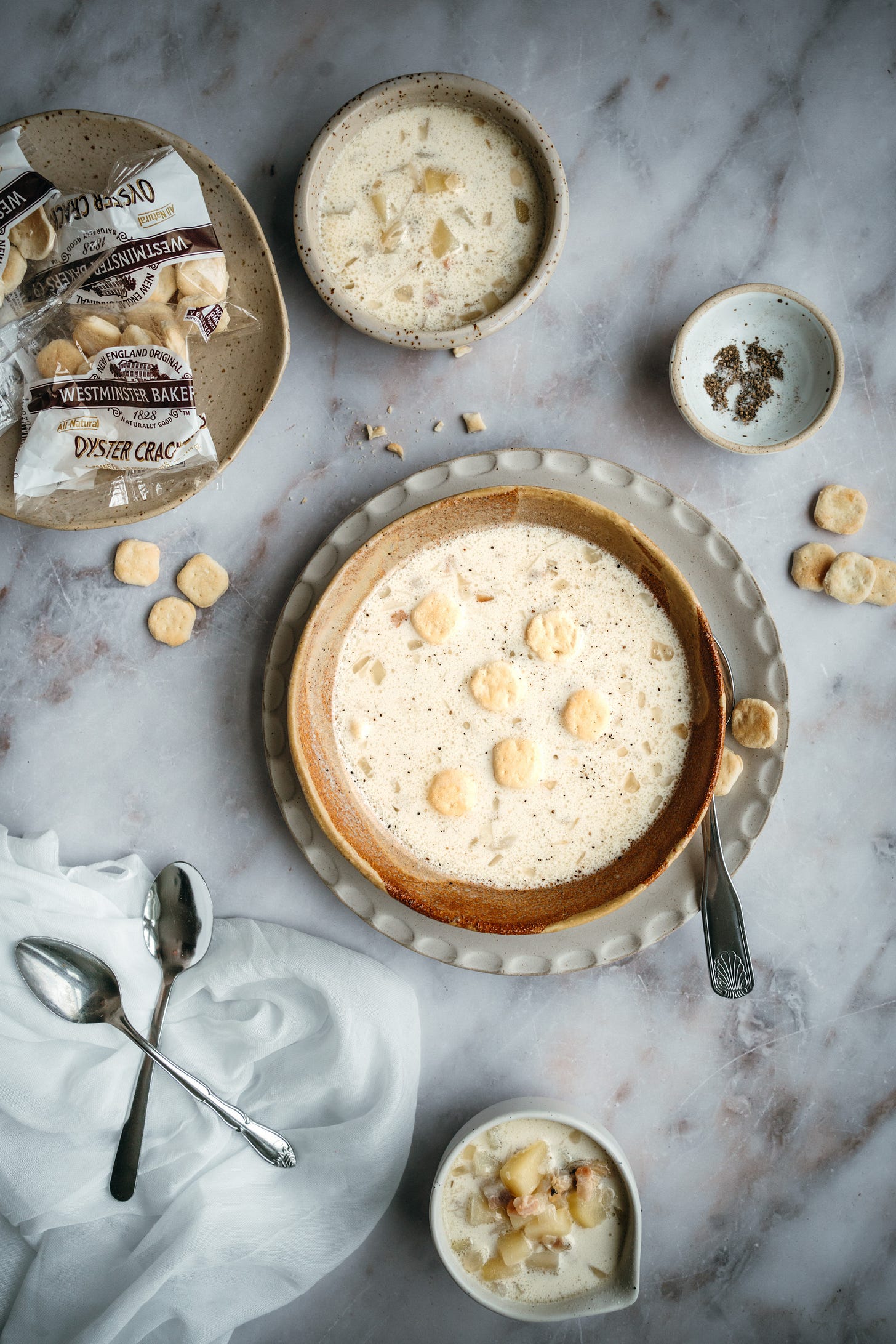
So embarrassed to say it's never even occurred to me to use fresh, steamed clams in my chowder. Dozens of chowders in my life, and all made with canned fruits of the sea! I'm so looking forward to trying this. And, I really like the idea of the tomato broth -- I think adding a dash to a creamy chowder might create some balance in flavor... Sometimes the blandness of a creamy/potato-y dish can only be remedied with a serious dose of bitterness or acidity. Thanks for the recipes, Elisabet. Beautiful post. 🌸